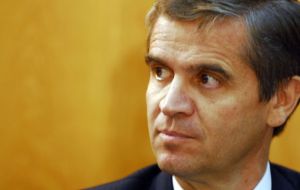MercoPress. South Atlantic News Agency
‘Copper insulated’ Chilean economy outperforming and Peso becoming too strong
 President Rodrigo Vergara: “the current real exchange rate within range”
President Rodrigo Vergara: “the current real exchange rate within range” The Chilean central bank raised its forecast for economic growth this year to between 4.75% and 5.25% (from 4% to 5%), adding that it expects GDP to expand 4% to 5% in 2013.
The bank expects stable interest rates in the short term and inflation of 2.5% this year and 3% in 2013, according to the quarterly monetary-policy report.
Policy makers raised their growth forecast on higher personal incomes due to low unemployment, increased access to credit for consumers and companies and investment in mining driven by the high price for Chile’s main export, copper.
But at the same time it said a global slowdown may damp exports and growth, and warned that it expected renewed periods of tension in international financial markets.
“Monetary policy faces two opposing forces,” central bank President Rodrigo Vergara told Senators in Valparaiso, according to copies of his Wednesday speech distributed to journalists in Santiago.
“On one hand, a weak external scenario that won’t add further stimulus to the economy, and on the other hand, strong domestic activity and demand with a tight labor market and little spare capacity.”
Since the central bank’s last monetary-policy report in June, Vergara has seen economic growth beat economists’ forecasts and annual inflation decelerate to a 20-month low in July.
The central bank has left its benchmark interest rate unchanged at 5% since January. Traders and investors expect the central bank to leave rates on hold for the rest of the year and lower the rate by a quarter point to 4.75% in the following six months, according to a bank survey published on Aug. 22.
Chile’s stable interest rates at a time when the central banks of Colombia and Brazil have lowered borrowing costs helped make the Chilean peso the most attractive currency in the world to invest in.
The currency’s rise and stable domestic consumer prices mean that Chile’s inflation-adjusted exchange rate reached the highest since December 2010 in July. That led to speculation the central bank would consider buying dollars to weaken the currency as it did in January 2011.
While the bank reserves the right to intervene in the currency when the real exchange rate is out of line with its fundamental drivers, “in current circumstances, it is not evident that those criteria apply,” Vergara said.
“The current real exchange rate, while low compared to a few months ago and relative to its average of the last 15 to 20 years, is within the range that fits with its fundamental drivers,” Vergara said. “An intervention has a significant financial cost for the central bank and the country”.
Copper which is the country’s main export (over half its overseas sales) and has experienced a sustained demand mainly from China in the last ten years is a permanent reference for the Chilean economy.




Top Comments
Disclaimer & comment rules-

-

-

Read all commentsComment removed by the editor.
Sep 06th, 2012 - 04:28 am 0?????????????????
Sep 06th, 2012 - 11:35 am 0Allende destroyed the Chilean economy. De nationalizing the copper industry and actively seeking foreign investment is what has worked. Comrade you have your facts completely wrong.
The problem with Allende was that he was an idealist with no real grasp of the consequences of his actions. Obviously, outside influences exacerbated the situation but the economy it would have reached the same conclusion.
Sep 06th, 2012 - 01:41 pm 0And the economy struggled under Pinochet for years. It was a bitter pill Chileans had to swallow for the long-term prosperity of their country. But I think most would say it was worth it now.
Commenting for this story is now closed.
If you have a Facebook account, become a fan and comment on our Facebook Page!